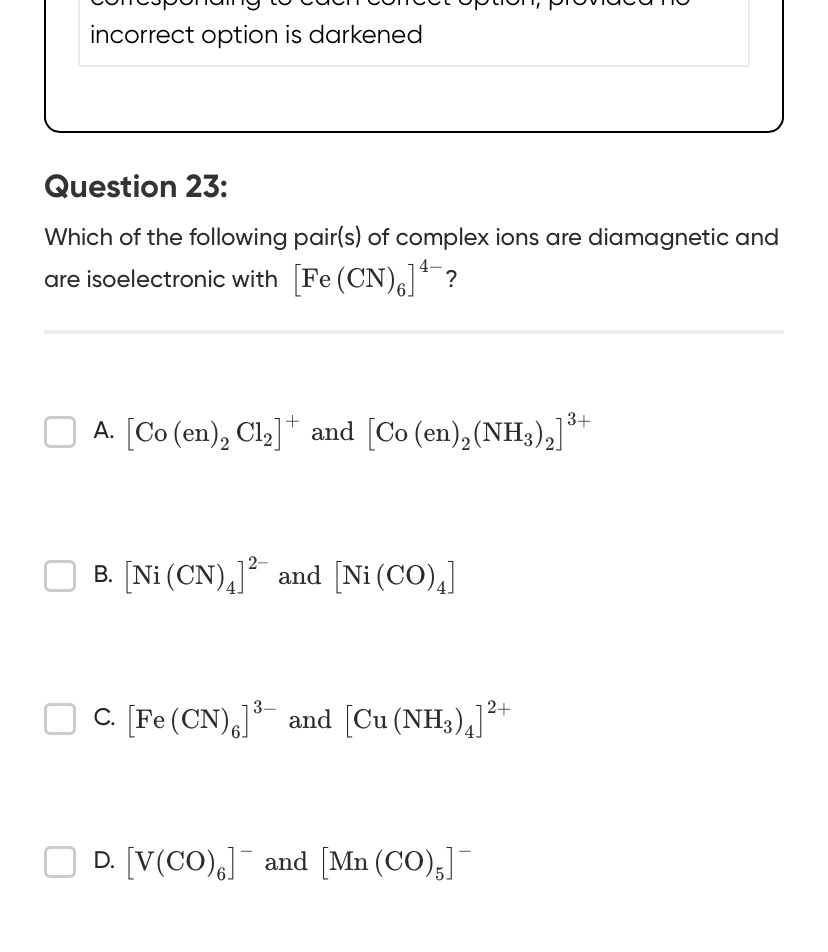Question
Question: Which of the following pair(s) of complex ions are diamagnetic and are isoelectronic with $[Fe(CN)_6...
Which of the following pair(s) of complex ions are diamagnetic and are isoelectronic with [Fe(CN)6]4−?

[Co(en)2 Cl2]+ and [Co(en)2(NH3)2]3+
[Ni(CN)4]2− and [Ni(CO)4]
[Fe(CN)6]3− and [Cu(NH3)4]2+
[V(CO)6]− and [Mn(CO)5]−
A. [Co(en)2Cl2]+ and [Co(en)2(NH3)2]3+
Solution
The reference complex is [Fe(CN)6]4−. The oxidation state of Fe is +2, and its electron configuration is [Ar]3d6. Since CN− is a strong field ligand, [Fe(CN)6]4− is a low-spin complex with configuration t2g6eg0, making it diamagnetic. We need to find pairs of complexes that are also diamagnetic and have a metal ion with a d6 electron configuration (isoelectronic with Fe2+).
Option A:
- [Co(en)2Cl2]+: Cobalt is in the +3 oxidation state (Co3+). Its electron configuration is [Ar]3d6. Ethylenediamine (en) is a strong field ligand, and Cl− is a weak field ligand. For Co3+ (d6), the complex is generally considered low-spin and thus diamagnetic (t2g6eg0).
- [Co(en)2(NH3)2]3+: Cobalt is in the +3 oxidation state (Co3+). Its electron configuration is [Ar]3d6. Both en and NH3 are strong field ligands for Co3+. This complex is low-spin and diamagnetic (t2g6eg0). Both complexes in Option A are diamagnetic and isoelectronic with [Fe(CN)6]4−.
Option B:
- [Ni(CN)4]2−: Nickel is in the +2 oxidation state (Ni2+). Its electron configuration is [Ar]3d8. This is not isoelectronic with Fe2+ (d6).
- [Ni(CO)4]: Nickel is in the 0 oxidation state (Ni0). Its electron configuration is [Ar]3d84s2. This is not isoelectronic with Fe2+ (d6).
Option C:
- [Fe(CN)6]3−: Iron is in the +3 oxidation state (Fe3+). Its electron configuration is [Ar]3d5. This is not isoelectronic with Fe2+ (d6). It is also paramagnetic.
- [Cu(NH3)4]2+: Copper is in the +2 oxidation state (Cu2+). Its electron configuration is [Ar]3d9. This is not isoelectronic with Fe2+ (d6). It is also paramagnetic.
Option D:
- [V(CO)6]−: Vanadium is in the -1 oxidation state (V−1). Its electron configuration is [Ar]3d6. This is isoelectronic with Fe2+ (d6). CO is a strong field ligand, so this complex is low-spin and diamagnetic (t2g6eg0).
- [Mn(CO)5]−: Manganese is in the -1 oxidation state (Mn−1). Its electron configuration is [Ar]3d64s2. This has 8 valence electrons, not 6, so it is not isoelectronic with Fe2+ (d6).
Therefore, only Option A contains a pair of complexes that are diamagnetic and isoelectronic with [Fe(CN)6]4−.
